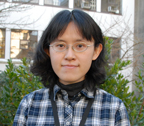Jonathan Griffiths

B.Sc. Biology/Biotechnology (2004) Carleton University,
M.Sc. Plant Sciences (2007) The University of Western Ontario.
I began my Ph.D. project in the Haughn lab in January, 2008 in gorgeous Vancouver, British Columbia. My M.Sc. work focused on the plant-pathogen interactions between Plum Pox virus and Arabidopsis translation initiation factors required for successful viral replication. For my Ph.D.research I am interested in the function and synthesis of pectinaceous mucilage secreted by the seed coat in Arabidopsis. A number of mutants have been identified that alter mucilage synthesis or secretion, but little is known about the composition and structure of mucilage. Currently I am trying to develop methods to gain insights into the structure of pectin; which will ultimately be used to characterize a population of mum-4 (mucilage modified 4). suppressor/enhancer mutants.
Gabriel levesque-Tremblay
 B.Sc. Biology (2005) University du Quebec a Montreal (UQAM) and University des Antilles et de la Guyane (UAG)
B.Sc. Biology (2005) University du Quebec a Montreal (UQAM) and University des Antilles et de la Guyane (UAG)
M.Sc. Biology (2009) University du Quebec in Montreal (UQAM)
I started my Ph.D. in September 2009. The focus of my research is pectin biosynthesis and regulation using the seed coat of Arabidopsis as a model system. I use both forward and reverse genetics to identify new gene candidates involved in theses processes. I’m currently part of the NSERC founded research group: Working on Walls co-supervised by George Haughn (Botany Department) and Shawn Mansfield (Forestry Department).
Lin Shi

M.Phil. Biology and Chemistry (2007) City University of Hong Kong
B.Sc. Biochemistry (2002) Nankai University
I started my PhD study in the Botany Department at UBC beginning in January, 2009, co-supervised by Professors Ljerka Kunst and George Haughn. My previous MSc. research and several years working as a biological researcher gave me valuable experience and also made me realize my passion for plant biology.
For my Ph.D. research, I am investigating the role of GLABRA2 (GL2) in seed oil biosynthesis and deposition in Arabidopsis thaliana. I intend to use a combined molecular and genetic approach to elucidate GL2 protein function, characterize the upstream regulation mechanism of GL2, and identify the downstream targets of GL2 in seed oil production.
Kresimir Sola

B.Sc. Biology (2012) University of Zagreb
I started my M.Sc. degree in September 2012. My research focuses on understanding properties of the seed coat mucilage using molecular and genetic techniques. I am trying to identify mechanisms through which plants control cell wall cohesiveness by isolating and cloning suppressors of the mucilage mutant mum2 that has defects in mucilage extrusion.
Yi-Chen Lee

B.Sc. Life Science (2007) National Taiwan University
M.Phil. Plant Sciences (2009) University of Cambridge
I started my Ph.D. in the Haughn lab in September, 2012. In my M.Phil. project, I studied signaling transduction between chloroplast and nucleus. My Ph.D. project focuses on the secretion of pectinaceous mucilage and a pectin-modifying enzyme, MUM2 in Arabidopsis seed coat. I use confocal microscopy and other microscope techniques to study the secretion pattern of MUM2 and the possibility that it is co-secreted with mucilage.
Robert McGee

B.Sc. Biological Sciences (2009) University of Canterbury, Christchurch, New ZealandM.Sc. Plant Biology (2014) University of Canterbury, Christchurch, New Zealand
I started my Ph.D. in the Haughn lab in September, 2013. My Masters project was a joint venture between the University of Canterbury and the NZ-government funded Plant and Food Research. This project focused on studying the genetic architecture within a genetic locus that controls parthenogenesis (asexual seed reproduction) in Hieracium praealtum. Staying in the field of seed biology, I have shifted gears with my Ph.D. project and I am now working on seed coat biology. The overall aim of my research is to engineer the mucilage composition in Arabidopsis thaliana seeds to determine how the composition of mucilage impacts its properties. In order to do this I need utilise a set of newly identified seed-coat specific promoters, which will be used to express carbohydrate active enzymes into the seed coat epidermal cells.
